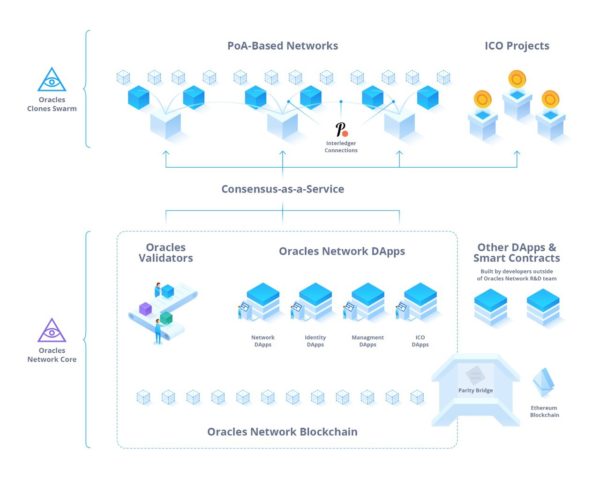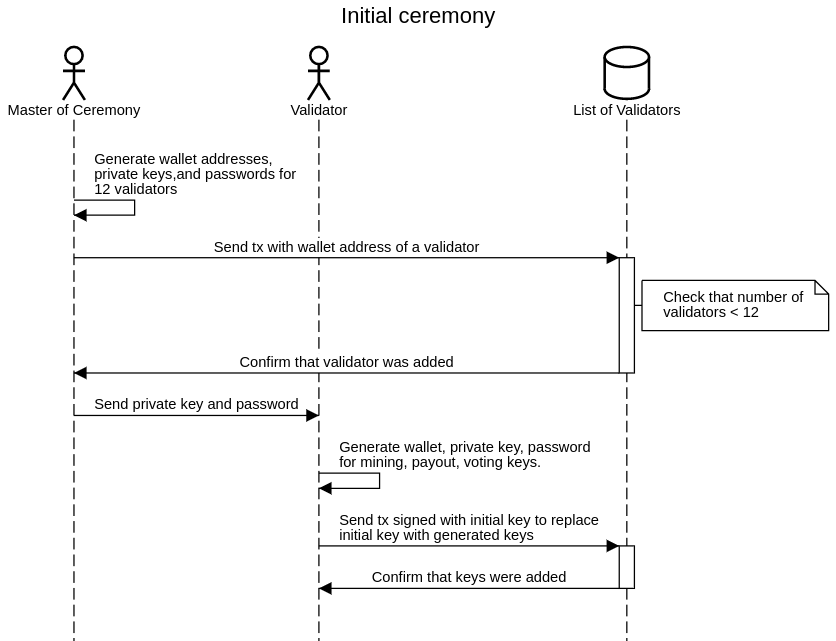POA Network is an open, public network based on the Ethereum protocol with the Proof of Authority (PoA) consensus obtained by independent pre-selected validators.
Although the Oracles Network is a fork of Ethereum, it is still a separate independent blockchain platform. The main feature of the Oracles Network is their Proof of Authority (POA) consensus mechanism, which can significantly reduce transaction fees and the use of smart contracts, and also ensures fast network operation.
The developers of POA Network determine the relevance of the development of their project with the demand for digital technologies. The network is a solution to the problem that arises when trying to transfer business to blockchain. Let’s explore the POA Network with Changelly!
Table of Contents
POA Network Basics
The idea of Oracle Networks was announced in April 2017. In August 2017, the test network was launched with 12 independent validators.
The POA Network is committed to addressing a key drawback of a blockchain, which is scaling. To solve this problem, the project implements the original idea of a new protocol for achieving consensus.
Proof of Authority is providing high bandwidth of POA Network. The principle of action is the formation of validators based on the confirmation of personal data, which become the key to so-called good faith.
The developers of the POA Network actually implement a masternode system involving real individuals. Becoming a validator, such a user transfers his personal data, which is checked and stored in the system.

All validators must have an active notarial public license in the United States. Because validator identifiers are publicly available, validators are more likely to act in the interests of the network.
The block will be generated with an average time of 5 seconds. Each Oracle network has a current capacity of about 1.5 million transactions per day. A faster network allows you to create new types of applications where the speed of response from distributed consensus is important. Since the Oracles Network is compatible with Ethereum, Ethereum dApps can be easily transported and run on the Oracles Network with faster response times and higher bandwidth.
Network replication is also part of the Oracles network strategy. There can be many network clones (called “Clone Swarm”), each serving a different community.
The Oracles Network also has a cross-chain bridge connecting any Ethereum compatible network. A typical use case would be an ICO project to raise funds from the Ethereum core network when issuing tokens to another, more cost-effective Oracles network. On a large scale, such bridges make it easy to transfer cost between networks.
To recruit the first 12 validators, a ceremonial master was used. It distributed the necessary keys among the first participants. Granting authority to form and verify blocks allowed the launch of a network with a high level of scalability.

A validator generates three keys in the Initial Ceremony DApp:
- mining key, required to participate in consensus and create blocks.
- voting key, required to create ballots and vote on ballots.
- payout key, not required. Used in Payout DApp to send daily mined coins from the mining key to the payout key. If a mining node should be compromised, an attacker will get daily earnings or less.
At the moment, the POA Network has 23 validators.
POA and the Competitors
| POA | Ethereum | EOS | NEO | Ripple | |
| Block Time | 5s | 15s | 0.5s | 15-20s | 4s |
| Validator/Block Producer Requirements | Trusted US Public Notary, willing to stake identity and reputation, meet specifications for server performance and emphasis on geographic diversity | Not possible on Ethereum | Ability to successfully produce a block. Includes crypto exchanges and mining pools | Must be within the NEO ecosystem. Every validator must know every other validator | Ripple validators meet specifications for server performance, networking capability, and geographic diversity |
| Validator Selection | Elected by a majority vote of current validators in a decentralized manner through on-chain governance | Token holders select validators. More tokens possession allows for more voting power | NEO’s team currently operates all validator nodes in the network | Ripple company adds trusted validators nodes based on diversification of identity, location, hardware and software | |
| Number of Validators/Mining Pools | 23 | 5 | 21 | 7 | More than 70 |
| Number of Entities in Control of >50% of Voting/Mining Power | 11 | 3 | 11 | 1 | 1 |
POA Token Value
Just as Ether operates on the Ethereum network, POA coins are used as transaction fees in the Oracles network. It is also used as a reward by validators for network security. POA20 is an ERC20 representation of POA native tokens on Ethereum network. The POA20 token displays the exact same properties as the standard ERC20 token and allows it to be used in all the same places that offer ERC20 compatibility.
The POA token is used for transaction fees within the network and to pay rewards to validators for certifying transactions. The more projects that will be implemented on the basis of the POA Network platform, the higher the cost of the POA token will be.

Current POA Token price is $0.013727. The coin takes 472nd place among all cryptocurrencies by market capitalization. The highest POA price of $0.952471 was tested on May 10, 2018. The minimal price was captured a couple of days ago, on August 17, 2019. The POA coin was worth $0.012455.
POA ICO
Initially, the creators of the platform installed a hard cap for the ICO in the amount of $25 million. However, this amount was halved. The developers did not offer any bonuses and discounts, which did not stop them from collecting the declared $12.5 million on the presale in a record 56 seconds.
All funds in the amount of 41176 ETH were collected on the presale in 58 seconds.
- Token Rate: 1 POA = 0.000233 ETH
- 70% of all tokens were sold, which corresponds to 176 722 560 POA
POA Roadmap
2019 for POA is a development year of increased adoption, improved consensus, and upgraded governance. Let’s highlight some important points:
- Increase adoption of POA Network by new DApps. Check DApps on POA on State of the dapps.
- Enhance great developer experience with blockchain explorer BlockScou and web wallet NiftyWallet
- Help DApps from Foundation network to scale on POA using TokenBridge
- Follow updates of Ethereum Foundation network, e.g. Constantinople and Ethereum 1.x
- Develop support for a new client on POA Core.
- Upgrade POA Core testnet from AuthorityRound consensus to HoneybadgerBFT (hbbft) consensus.
- Increase number of validators to 25 validators.
POA Latest News
POA20 token is listed on the Uniswap Exchange! Uniswap is a unique DeFi (decentralized finance) project which allows users to easily swap ERC20 tokens with ETH as well as directly with other listed ERC20 tokens. The protocol design provides inexpensive gas prices and exchange rates which are calculated and regulated through on-chain protocols and trading arbitrage.
POA Wallets
POA is supported by a wide range of wallets compatible with Ethereum system. Check it out!
- Alpha Wallet is a mobile wallet available for iOS and Android.
- MyEtherWallet, Metamask, and Trust Wallet, which are compatible with ETH tokens.
- Nifty Wallet is a web wallet, which works as an extension to Chrome. Nifty Wallet provides an easy way to access the xDai Chain and other Ethereum based networks, and interact with compatible Ethereum Chain Distributed Applications (DApps) through the browser.
- Ledger Nano Wallet is a hardware wallet for your cryptocurrency.
Where to trade POA and POA20 Tokens?
You can buy and trade both POA and POA 20 Tokens. The first table is showing the exchanges that operate with POA token, and the second table is for POA20 tokens.
POA
POA20
| Exchange | BTC | ETH | USD | DAI | BNT |
| HitBTC | • | • | • | • | |
| Uniswap | • | ||||
| Banсor Network | • |
POA Summary
There are some excellent points in favor of POA Network:
- fast transactions and processes, support for applications and projects requiring a high level of scalability;
- distributed between independent and verified centers network;
- joint management and decision making; new validators can be included in the system only by voting results;
- the presence of a bridge for communication with the broadcast platform and the ability to integrate its projects on the POA Network site;
- Hard fork protection and streamlined branching.
Investing in a POA Network is controversial. On the one hand, the concept is original and in demand, many projects can be transferred from the original broadcast platform to the proposed site.
However, the issue of relevance rests entirely on the development of Ethereum. If it manages to successfully implement the increase in bandwidth, then we should not expect great prospects from the POA Network. Developers in this situation will take considerable time to implement enough innovative ideas into their project and make it competitive.
Disclaimer: This article about POA Network should not be considered as offering trading recommendations. The cryptocurrency market suffers from high volatility and occasional arbitrary movements.
Any investor should research multiple viewpoints and be familiar with all local regulations before committing to an investment.
